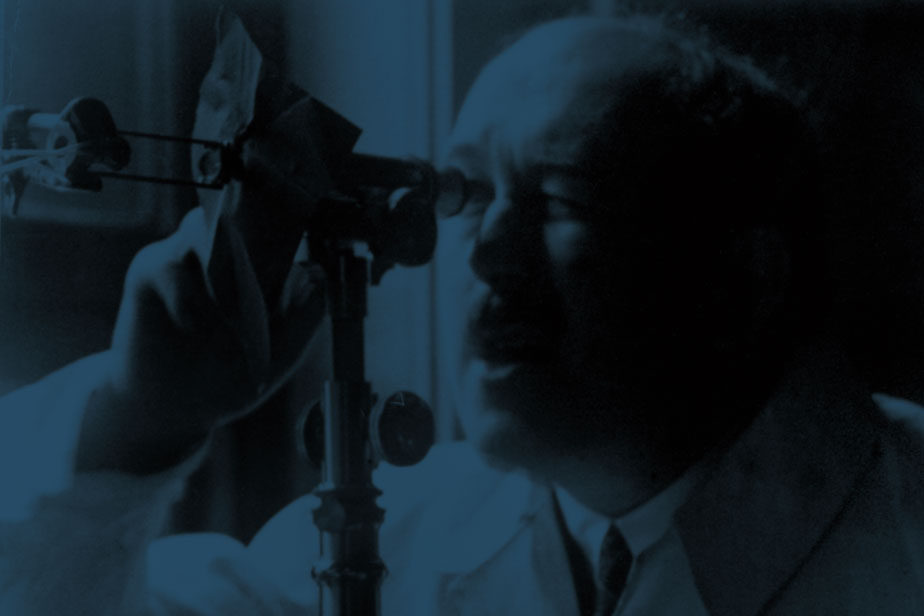Fields of Research
Fields of Research
In 2019, the University is either leading or taking part in 4 clusters of excellence, 16 collaborative research centers, 19 DFG research units, and 35 Priority Programs, testifying to its extraordinarily multifaceted research profile. It is characterized by the 5 core research areas Climate, Earth and Environment; Photon and Nanosciences; Particle, Astro- and Mathematical Physics; Manuscript Cultures; and Infection Research. Thanks to the Wissenschaftliche Anstalten—various academic institutions throughout the city—and the Colonial Institute, science and scholarship had played a major role in Hamburg even before the University was founded. The city was able to attract renowned researchers to these institutions, thanks in no small part to funding for professorships from the Hamburgische Wissenschaftliche Stiftung (Hamburg scientific foundation). The new university also attracted brilliant minds in its first decades, especially in physics, but also in other fields.
Otto Stern and Physics in Hamburg in the 1920s
In the 1920s, the Hamburgische Universität, as it was called in German, evolved into a world-renowned center for physics. And Otto Stern was, as his name suggests, its “star.” Stern built up the Institute of Physical Chemistry between 1923 and 1933. His pioneering work in the fields of atomic, molecular, and nuclear physics was highly admired and he was awarded the Nobel Prize in 1943. Stern attracted researchers to Hamburg from all over the world, including Wolfgang Pauli, Isidor Rabi, Emilio Segrè, and Hans Jensen, who would all go on to become Nobel Prize winners as well. This golden era ended in 1933: facing expulsion from the University for being Jewish, Otto Stern emigrated to the United States.
Universität Hamburg, Arbeitsstelle für Universitätsgeschichte
Otto Stern as dean, 1930-31
Excellent!
In July 2019, the University was chosen as one of eleven winners of the Excellence Strategy of the Federal and State Governments and awarded the title University of Excellence. This makes it one of Germany’s top research-intensive universities—a fact confirmed by the German Council of Science and Humanities (Wissenschaftsrat). As a flagship university, Universität Hamburg is committed to innovation and collaborative research in greater Hamburg. It generates and fosters sustainable know- ledge, education, and knowledge exchange nationally and internationally.Otto Stern (1888–1969) in Hamburg
Otto Stern came to Hamburg in 1923. As a full professor of physical chemistry, he was given his own institute, where he maintained a laboratory of world renown. With his colleagues from the neighboring institutes of theoretical and applied physics, Stern made Hamburg into one of the world’s leading centers for physics.Otto Stern in his Hamburg laboratory, 1920s Universität Hamburg, Center for the History of Universität Hamburg
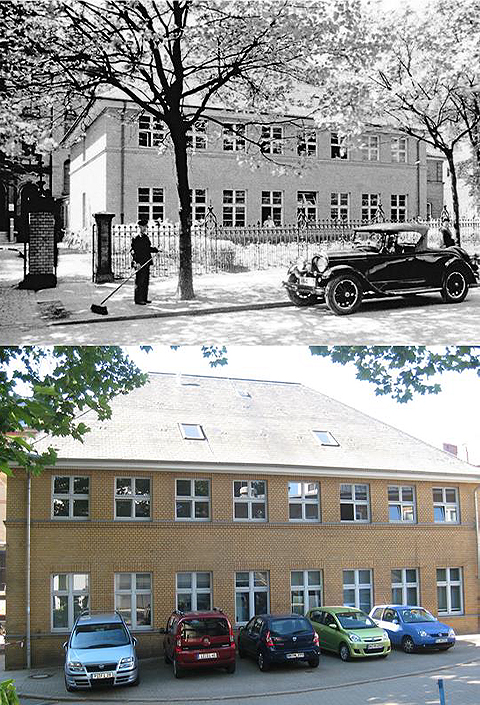
Universität Hamburg, Arbeitsstelle für Universitätsgeschichte
After Otto Stern had received a call from the University of Frankfurt, he succeeded in enforcing a new building for his institute in Hamburg. The 1931 related building is still on the campus on Jungiusstraße.
Teamwork
Otto Stern formed a successful working group with his assistants, his fellows from abroad, and his students. The group, however, was torn apart in 1933, when the University dismissed his three assistants because they were Jewish. With the dissolution of the group and Stern’s resignation, one of Hamburg’s most productive periods in physics was ended.Involvement in University Administration
Otto Stern was highly respected at the University. In 1930 – 31, he was dean of the Faculty of Mathematics and Natural Sciences, and in the following semesters a member of the University senate.Otto Stern as dean, 1930–31
Nobel Prize for Otto Stern
Otto Stern received the 1943 Nobel Prize in Physics “for his contribution to the development of the molecular ray method and his discovery of the magnetic moment of the proton.” The Prize was retroactively awarded in 1944. Since 1925, his colleagues, including Albert Einstein, Niels Bohr, and Max Planck, had nominated him for the Prize eighty-one times.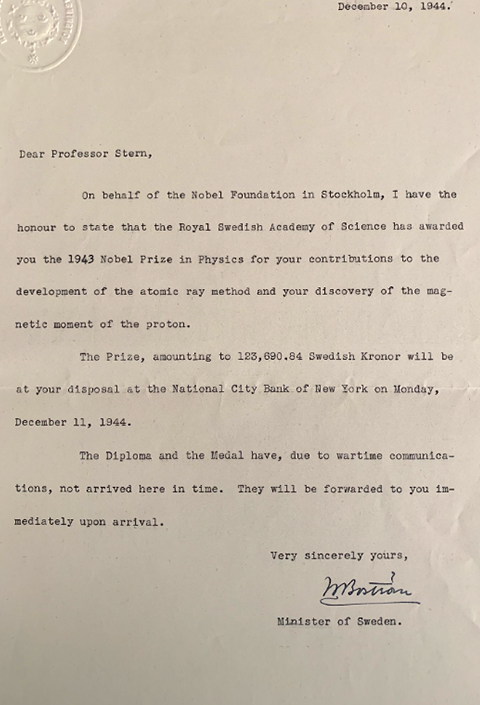
Nachlass Otto Stern, Diana Templeton Killen, Stanford, USA
Letter from the Nobel Prize Committee to Otto Stern, 1944, Otto Stern Heritage, Diana Templeton Killen, Stanford, USA

Nachlass Otto Stern, Diana Templeton Killen, Stanford, USA
Otto Stern’s Nobel Prize diploma, 1943
Hamburg—A Breeding Ground for Nobel Prize Laureates
Alongside Stern, Isidor Rabi also received the 1944 Nobel Prize in Physics. Rabi had worked with Stern as a fellow in Hamburg. In the 1920s, Hamburg was a magnet for young physicists from all over the world. Several of them—W. Pauli, E. Segré, and H. Jensen—later also became Nobel laureates.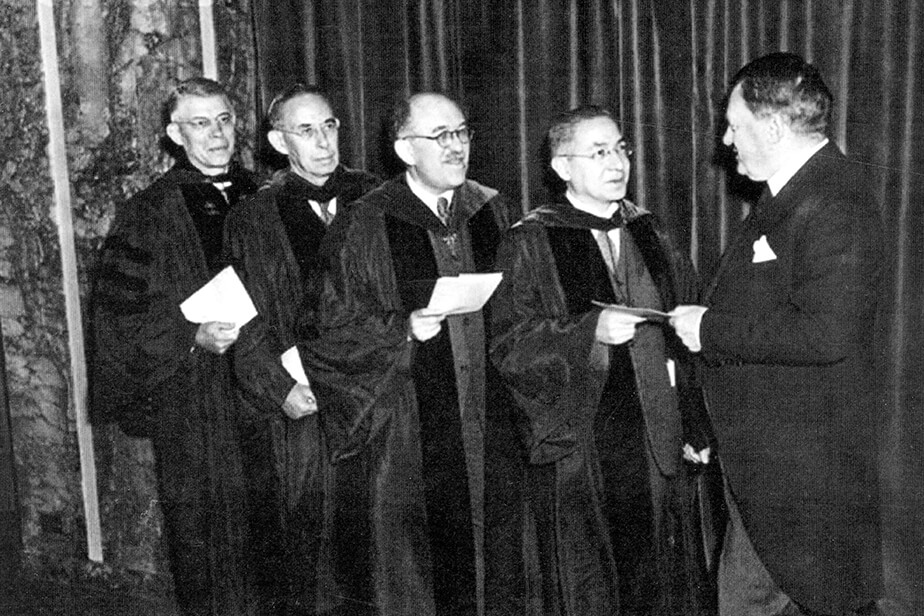
Nachlass Otto Stern, Diana Templeton Killen, Stanford, USA
The Swedish ambassador presents Stern
(third from left) and Rabi (second from right) with the Nobel Prize for Physics
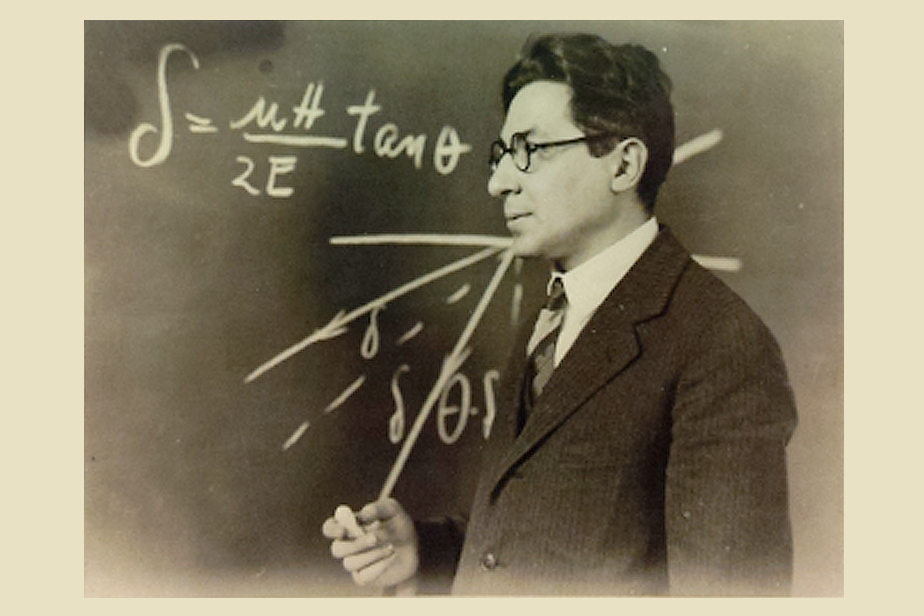
Universität Hamburg, Arbeitsstelle für Universitätsgeschichte
Isidor Rabi as a Fellow with Otto Stern in Hamburg, 1927
Wolfgang Pauli
Wolfgang Pauli came to Hamburg in 1923 as an assistant and became a professor in 1926. His years in Hamburg were among the most productive of his career. He developed into one of the foremost theoreticians in the new field of quantum physics and discovered what came to be called the Pauli exclusion principle, for which he was awarded the 1945 Nobel Prize in Physics.
Universität Hamburg, HStA, Universitätsarchiv, 361-6 I 311 Bd.1
Announcement for Wolfgang Pauli’s inaugural lecture, 23 February 1924
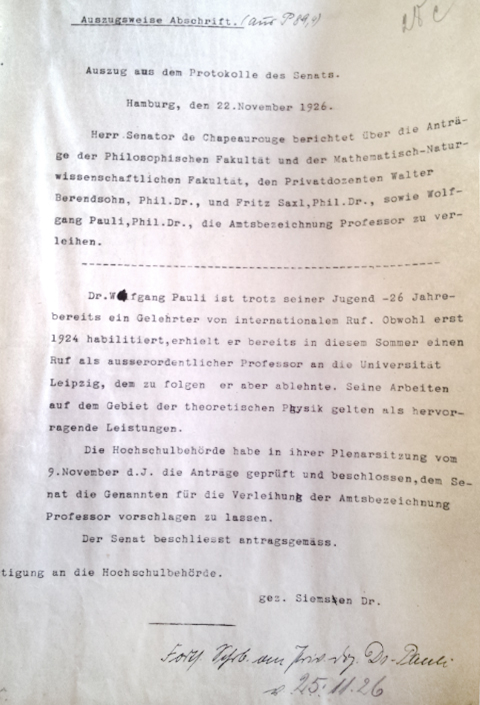
Universität Hamburg, Staatsarchiv Hamburg, Universitätsarchiv, 361-6 I 311
To prevent that Wolfgang Pauli became a profesor in Leipzig, the University in Hamburg offered him a Job in 1926.
Friends and Colleagues
Although Pauli was a theoretical physicist and Stern did his experiments at the Institute of Physical Chemistry, the two drew inspiration from each other for their work. According to Pauli, the two were life-long friends. “… under Stern’s influence, [I switched] from water directly to champagne.”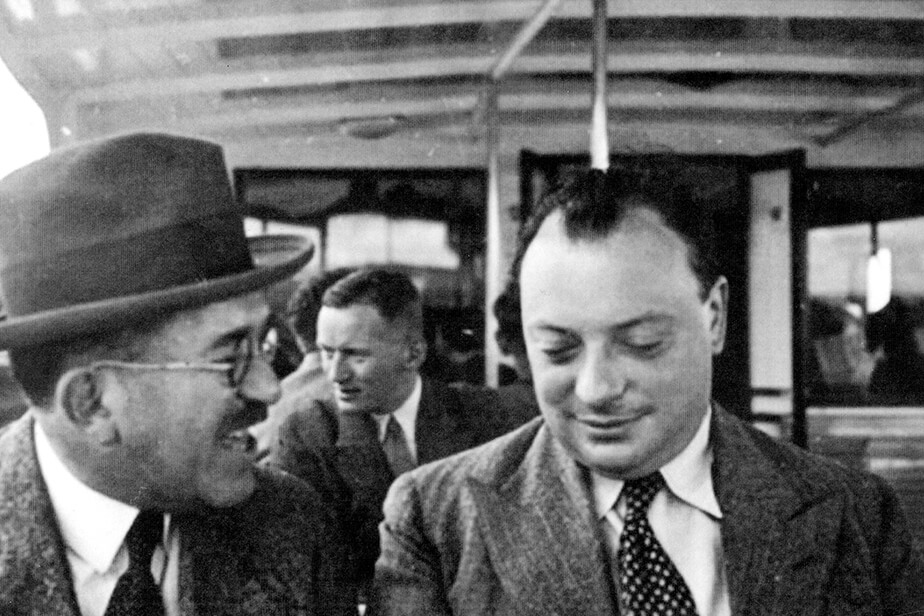
ETH-Bibliothek Zürich, Bildarchiv, Portr_14123-001 / Public Domain Mark
Otto Stern and Wolfgang Pauli in Zürich, ca. 1935
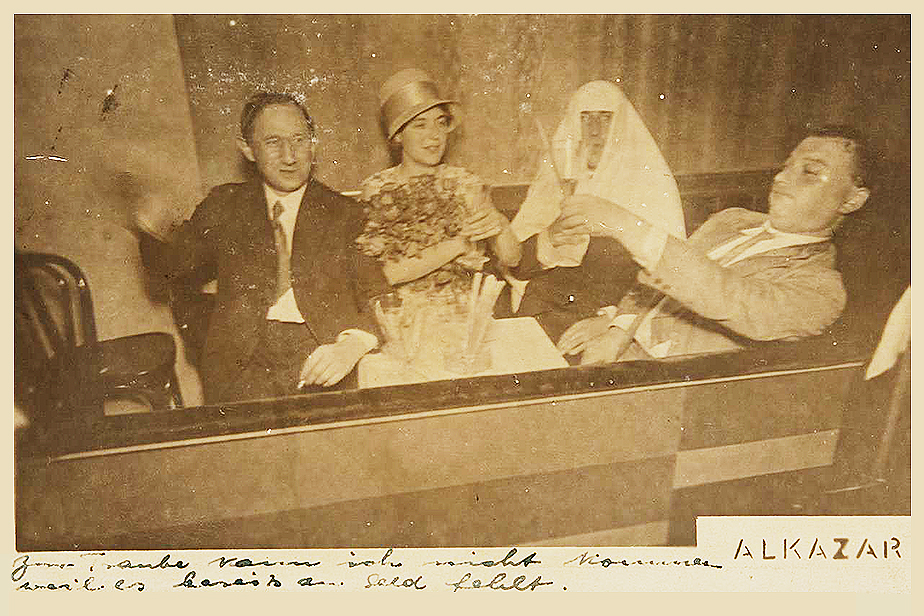
Univeristät Hamburg, Arbeitstelle für Universitätsgeschichte
Stern and Pauli in the ballroom ALKAZAR on the Reeperbahn in Hamburg. Otto Stern had disguised himself as a sheikh.
Acts of Friendship
After Otto Stern emigrated to the US, he supported other emigrés. His concern for his former colleagues in Germany extended well past 1945. He sent care packages to Hans Jensen, the 1963 Nobel laureate in physics, who had been his assistant in Hamburg in 1932. Thereupon the two began a regular correspondence.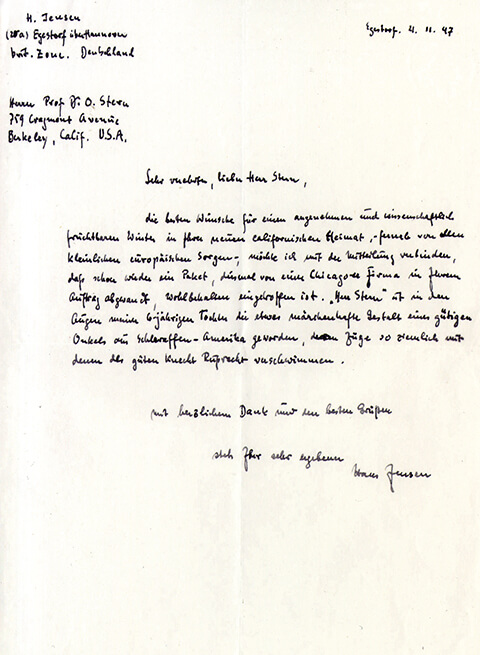
The Bancroft Library, University of California, Berkeley
Thank-you letter from Hans Jensen to Otto Stern for a care package, 1947
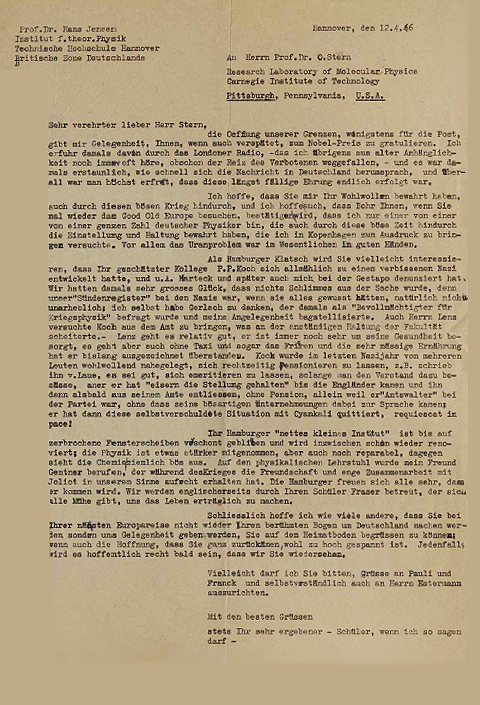
The Bancroft Library, University of California, Berkeley
Hans Jensen tells Otto Stern in this letter what happened between 1933 and 1945 at Stern's former institute.
The Bancroft Library, University of California, Berkeley
Stern’s Experimental Work
Stern’s research methods were considered ingenious. Using a magnet now on display at the Institute of Physical Chemistry, Stern conducted experiments on the development of molecular radiation technology. The statics of the exhibition space prevent us from displaying the original magnet, which weighs roughly 400 kg.Photographic representation of the replica of the Stern-Gerlach experiment, based on Stern’s records, at the Institute of Physical Chemistry
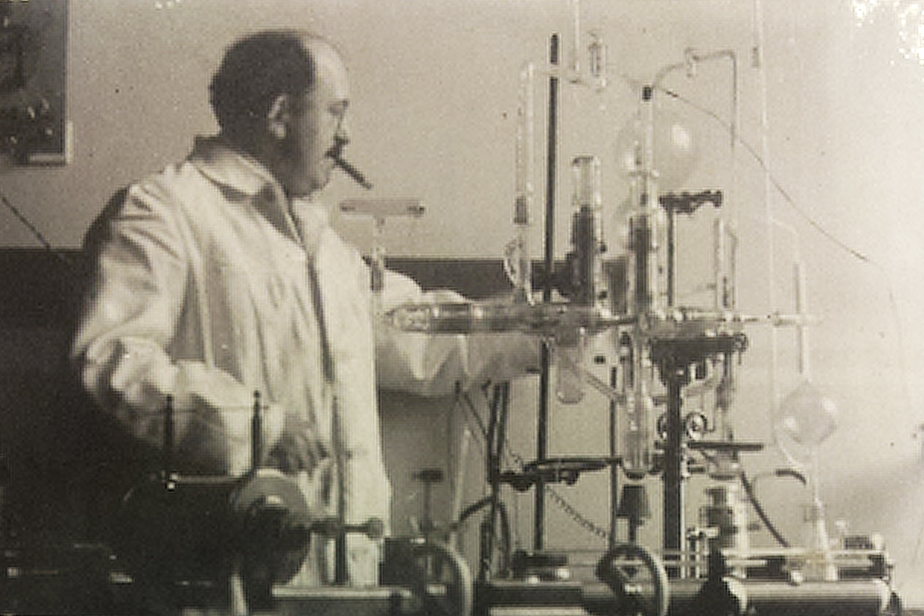
Universität Hamburg, Arbeitsstelle für Universitätsgeschichte
Otto Stern experimented with a cigar. The cigar smoke played an important role in the proof in the Stern-Gerlach experiment.
The Wave Characteristics of Matter
With his molecular ray method, Stern developed a measurement method with which the inner characteristics of atoms and molecules could be studied. With it, he was able to demonstrate the wave nature of atoms and molecules, thus confirming the concept of wave-particle duality in the young field of quantum physics.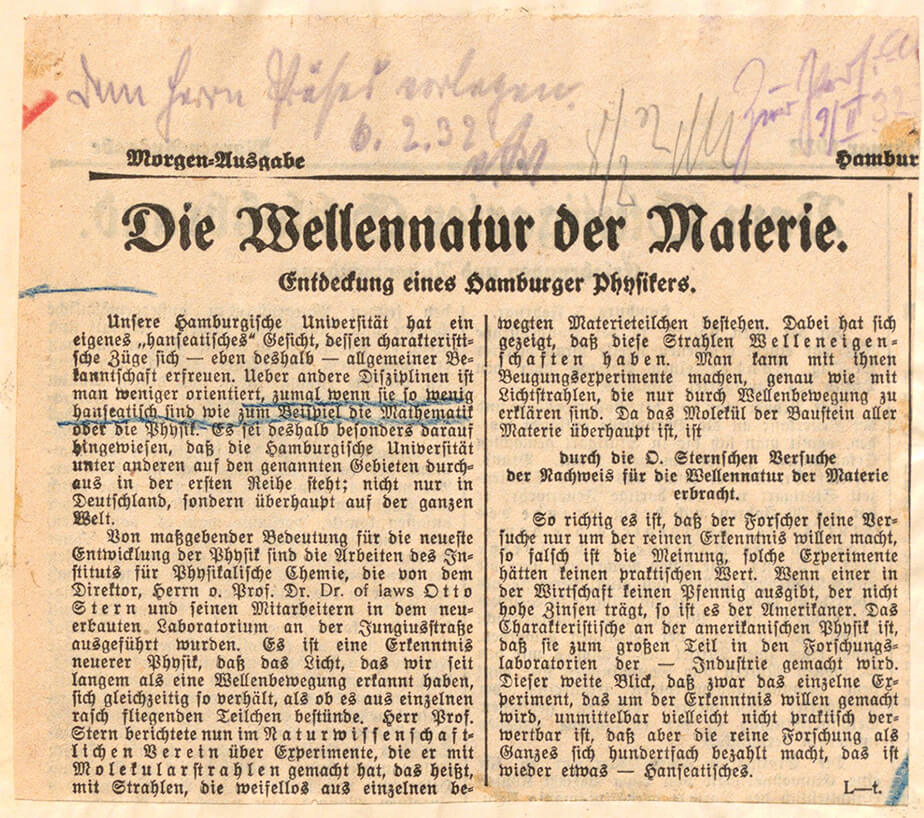
Universität Hamburg, HStA, Universitätsarchiv, 361-6_I 80
“The Wave Nature of Matter,” newspaper article from the Hamburger Fremdenblatt, 6.2.1932

Universität Hamburg, HStA, Universitätsarchiv
Otto Stern's publication on the molecular beam method for which he later received the Nobel Prize. Otto Stern, On the method of molecular beams I. Zeitschrift fur Physik 39, S. 751- 763, 1966
Dismissal From Civil Service
Otto Stern preempted his pending dismissal for being Jewish. In 1933, he sent a telegram requesting his release from the civil service. He emigrated to the US, where he became a professor at the Carnegie Institute of Technology in Pittsburgh. He was never able to achieve the same success as in Hamburg, however.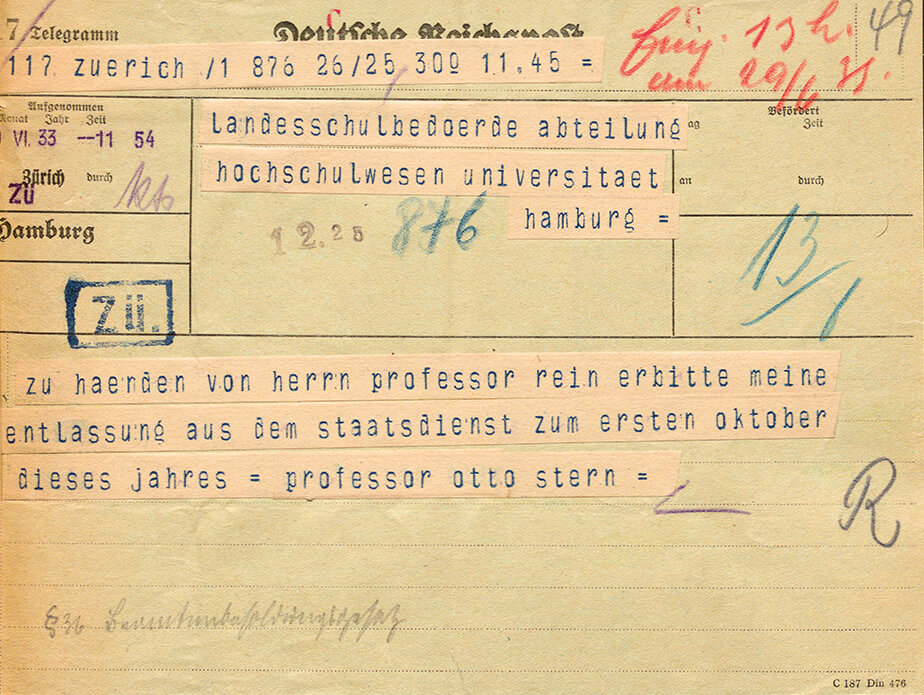
Universität Hamburg, HStA, Universitätsarchiv, 361-6 I 80
Telegram from Otto Stern, sent from Zürich on 29 June 1933
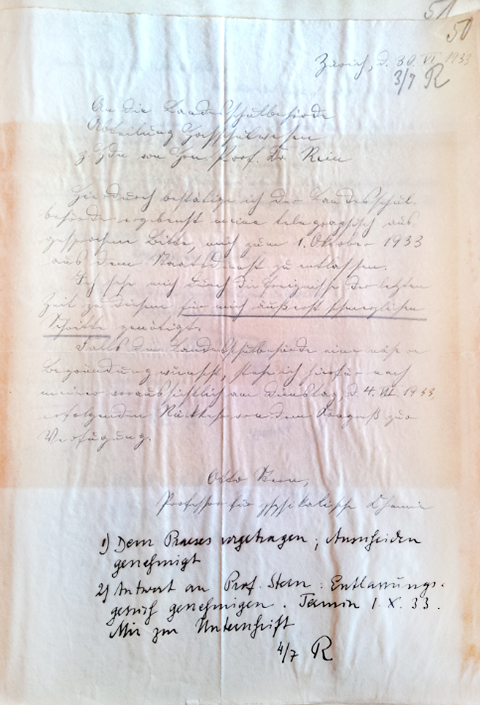
Personalakte Otto Stern StA HH Hochschulwesen Dozenten- und Personalakten 361-6 I 80, 50
Letter Otto Stern to the regional school authority, which follows his telegram: "By this I confirm the Landesschulbehoerde my telegraphically expressed request to dismiss me on October 1, 1933 from the civil service. I have been forced by the events of recent times to this extremely painful steps for me. If the Provincial School Board wishes for a more detailed explanation, I stand for this according to my expected on Tuesday, d. 4.VII. 1933 returning from the Congress available. Otto Stern, Professor of Physical Chemistry "
The Hamburg Centre for Ultrafast Imaging (CUI): Cluster of Excellence Advanced Imaging of Matter
There are 330 physicists, chemists, and structural biologists wor-king in the cluster of excellence for photon and nanosciences. They “observe, understand, and monitor” atoms and molecules to discover the principles behind the origin of certain characteristics.Film: CUI (The Hamburg Centre for Ultrafast Imaging): Cluster of Excellence Advanced Imaging of Matter
Cluster of Excellence: Climate, Climatic Change, and Society (CLICCS)
About 210 scientists from more than fifteen natural science, economic, and social science disciplines work in the Climate, Climatic Change and Society cluster of excellence. They study issues related to the future of the climate and the interplay between climate change and society.Film Climate, Climatic Change, and Society (CliCCS)
Cluster of Excellence: Understanding Written Artefacts
Currently, 130 scholars of the humanities and natural sciences study the use and function of written artefacts and the materials upon which they were written, from manuscripts to inscriptions to graffiti. Central to their research is the worldwide diversity of the written word: from the beginning of writing to the present day.Film: Understanding Written Artefacts
Cluster of Excellence: Quantum Universe
What is dark matter? What can gravitational waves teach us about the Big Bang? Many questions about the creation and development of the universe remain unanswered. More than 300 physicists and mathematicians are working together to find new answers from the fields of cosmology, particle physics, and quantum theory.Film Quantum Universe
Research for Freedom and Democracy
In 1923, the Institut für Auswärtige Politik, a center for inter-national policy, was founded in Hamburg. It was one of the world’s pioneers in interdisciplinary research on peace and the causes of war. The head of the institute, Albrecht Mendels-sohn Bartholdy (1874–1936), had held the chair for civil law, international law, and international civil and procedural law in the University’s law faculty since 1920. Due to his accomplishments as an international law expert, he was named as a judge to the International Court of Justice in 1925. In 1931, he became the German delegate to the League of Nations. In 1933, Mendelssohn Bartholdy was forced to retire.Albrecht Mendelssohn Bartholdy’s area of specialty was international law.
Business Administration: Research and Praxis
The first chair for business administration was established in 1927 at the faculty of law and statecraft at Universität Hamburg. Curt Eisfeld (1886–1969) brought to the chair many years of experience in business. Until his retirement in 1951, Eisfeld’s main areas of concentration were banking and insurance. He was instrumental in initiating the creation of a degree program and exam regulations for business administration. The estate’s library testifies to Eisfeld’s many interests and activities in research and teaching.Curt Eisfeld: Hamburg’s first professor of business administration, 1947
Ernst Cassirer (1874–1945)
Cassirer counts among the 20th century’s most influential philosophers. In 1919, he became a tenured professor in the University’s philosophy faculty. In 1929/1930, he was named rector. It was here that he wrote his three-volume The Philosophy of Symbolic Forms, a work of cultural philosophy that takes a close look at the manifold ways human beings understand the world. Cassirer engaged in a heady exchange with the cultural scientist and private tutor Aby Warburg. As a committed democrat, Cassirer used his lectures and academic papers to defend the values of freedom and reason. He was forced out of his position in 1933 and went into exile.The philosopher Ernst Cassirer taking a stroll on the North Sea, 1928
The Path to European Thought
The emergence of European thought began with the ancient Greeks and revealed itself in the evolution of the meanings of words. It was this idea that Bruno Snell (1896–1986), chair for classical philology and one of the most important Greek scholars of the 20th century, made the focus of his work. Snell was a professor at the University from 1931 until his retirement in 1959, despite his critical views of the National Socialist regime. As rector from 1951 to 1953, Snell strove to reintegrate the University into the international landscape. At the end of Second World War, he initiated the archive of Greek lexicography. In 1955, he founded the Europa Kolleg Institute for European Integration.The Greek scholar Bruno Snell was an avid champion of an integrated Europe.
War Guilt: The Fischer Controversy
In his 1961 study Germany’s Aims in the First World War, the Hamburg historian Fritz Fischer (1908–1999) reinterpreted the role played by German leaders at the outbreak of the First World War. According to Fischer, the empire did not simply “slip into” war but purposefully instigated it to pursue far-reaching goals. Fischer’s thesis caused great controversy among historians, who publicly debated Germany’s responsibility for the war and the continuities between the First and Second World Wars. The controversy led to further intensive research on the causes of the First World War.First World War: Germans throwing hand grenades
Meteorology: More Than Just Weather and Climate
Even before the Institute of Meteorology was founded in 1929, researchers such as polar explorer Alfred Wegener gave lectures at the University. From its modest beginnings, the Institute evolved into one of today’s largest German university institutes for climatology and meteorology. The Institute has a long tradition of interdisciplinary research and close collaboration with external research institutions. Research in marine meteorology has been a long-standing focus. Since the 1980s, investigating the causes of environmental damage has become increasingly important.
Universität Hamburg, Meteorologisches Institut. Foto: Hartmut Kapitza.
Students erecting a mast as part of the MESOKLIP field experiment, 1979

Universität Hamburg, CEN, Foto: Frank Harms
View into the measuring section of the large boundary layer wind tunnel WOTAN with a model of the inner city area of Hamburg.
Towards a Modern-Day Criminology
Moritz Liepmann (1869–1928), the first tenured professor to hold the chair for criminal, judicial, and procedural law established in 1919, is also considered the father of modern criminology. His concept of reformed detention for young offenders was based on new educational principles. The psychologist and social researcher Curt Bondy (1894–1972), who received his Habilitation under Liepmann, continued to pursue Liepmann’s ideas until he was forced into exile. The sociologist Fritz Sack (*1931) revamped criminology at the University in 1984 by championing criminological social research.Young prisoners from Hahnöfersand
working with horses, 1926
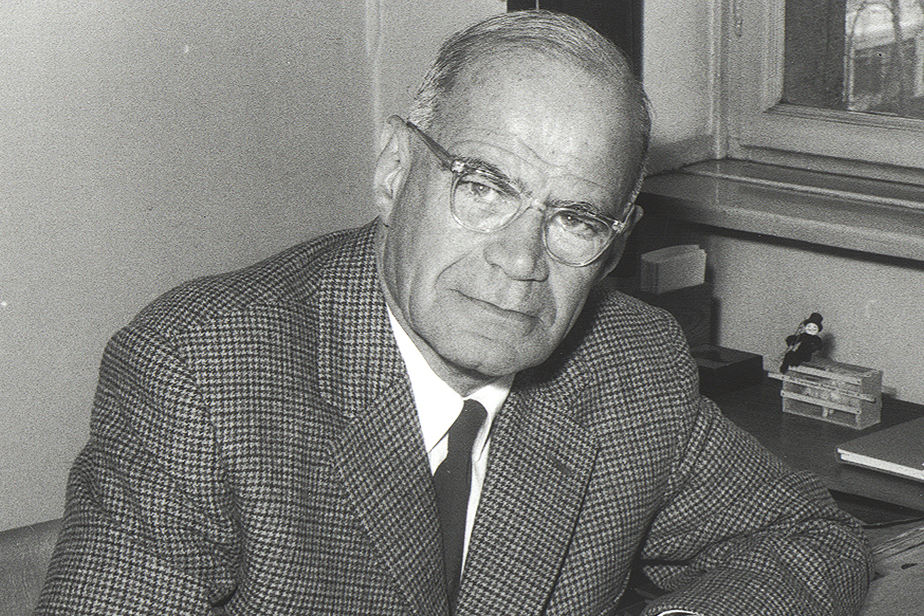
Universität Hamburg, Arbeitsstelle für Universitätsgeschichte
he psychologist and social researcher Curt Bondy in his study room in the "horse stable"
Pascual Jordan and Theoretical Physics
Alongside Max Born and Werner Heisenberg, the physicist Pascual Jordan (1902–1980), who received his Habilitiation in Göttingen in 1926, developed the foundation of quantum physics in the 1920s. From 1928 to 1929, Jordan was a Privatdozent at the University, meaning he was a senior lecturer without a permanent teaching contract. After he was “de-nazified,” Jordan was a visiting professor at the University’s state physics institute from 1947–1953. In 1953, the professorship was made permanent. Until Jordan retired in 1970, his research on the theory of relativity and gravitational physics made the institute one of the most important places for theoretical physics.Pascual Jordan’s thinking and research were interdisciplinary.
Politics as an Academic Subject
It was here in Hamburg in 1927 that Siegfried Landshut (1897–1968) became the first person at a German university to attempt to receive his Habilitation in politics—in vain. In 1951, after he returned from exile, Landshut was the first to hold the chair for “the science of politics,” a position he held for fourteen years. He edited and published the early works of Karl Marx, introducing them to the wider public. Landshut was especially interested in the possibilities for just political systems to balance the competing demands of freedom, equality, and sovereignty.After 1945, Siegfried Landshut was one of the founders of political science.
The Psychological Laboratory
As one of the main actors to champion the founding of the University, William Stern (1871–1938) took over as head of the philosophy seminar and the Psychological Laboratory, which served as a kind of pacemaker in the Weimar Republic. Stern founded differential psychology and is considered the inventor of the IQ test. In addition to Stern’s research on developmental psychology, the works of his associates Curt Bondy, Heinz Werner, and Martha Muchow were also path-breaking. Their applied research approaches brought together the humanities, the social and the bio-sciences.The psychologist William (Ludwig Wilhelm) Stern in his office
... More Research
Today, over 4,400 researchers work in several disciplines. Over the last 100 years, many of our researchers have done ground-breaking work in their subjects and won international renown. In every decade since its founding, the University has produced outstan-ding science and scholarship, with the exception of the years between 1933 and 1945, when the National Socialists persecuted such illustrious figures as Ernst Cassirer, William Stern, and Albrecht Mendelsohn Bartholdy and sent an entire generation of young academics to the trenches.
Ralf Dahrendorf studied philosophy and classical philology at the University of Hamburg until 1952. In 1958 he returned from England to teach two years as a professor of sociology at the Hamburg Academy of Social Sciences and the University. As a scientist Ralf Dahrendorf devoted himself to conflict theory, social change and the liberal society. In the 1960s, he determined as a liberal reform politician, the German debates on political participation and improved educational opportunities significantly.
Legendary in 1968 was his public exchange with the "student leader" Rudi Dutschke. Ralf Dahrendorf and student leader Rudi Dutschke met in November 1967 at a podium discussion in the Audimax.
Legendary in 1968 was his public exchange with the "student leader" Rudi Dutschke. Ralf Dahrendorf and student leader Rudi Dutschke met in November 1967 at a podium discussion in the Audimax.
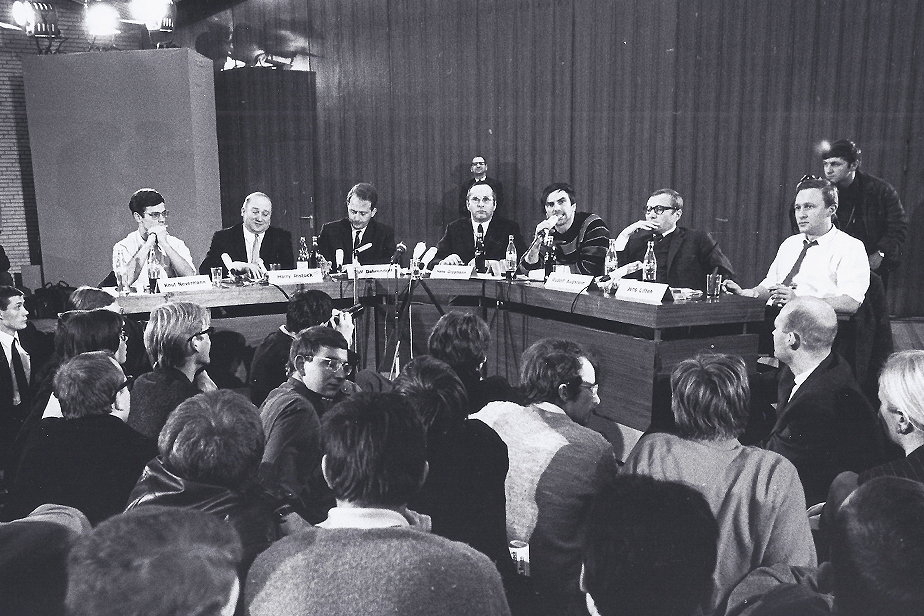
Staatsarchiv Hamburg, Contipress
Ralf Dahrendorf and student leader Rudi Dutschke
